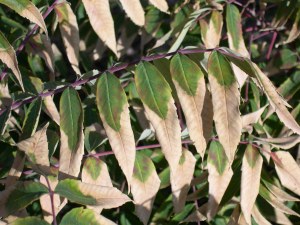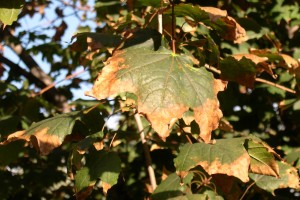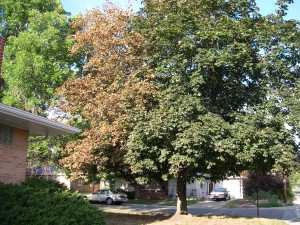“What’s wrong with the tree?” is a question frequently asked in our office at this time of the season. And for the most part, the answer is: tree scorch and symptoms of lack of winter water. 
Winter is a tough time for folks to think of watering trees, what with all of that chilly weather and bare branches. But roots dehydrate in dry soils and this past winter was bone dry. Here’s the surprise for most people: the result of no winter water is seen in mid-summer, when trees struggle with scorched leaves.
Yes, it seems counter-intuitive, but if you don’t have the roots to support a lush canopy, the leaves lose water faster than the stunted root system can replace. This means leaves brown for seemingly no reason, and drop from the tree.
 Look for evenly discolored spots on leaves, typically from the tips inward but not always. The discolored area have no rings, halos or fruiting bodies – if you see any of those things, you should suspect fungus or bacteria.
Look for evenly discolored spots on leaves, typically from the tips inward but not always. The discolored area have no rings, halos or fruiting bodies – if you see any of those things, you should suspect fungus or bacteria.
On pines, the needles will brown with no rings or banding, becoming brittle and dry. Deciduous trees may loose a bit of canopy at this time as well, in response to high heat and low water. This is normal, but if the tree loses a lot of the canopy it’s probably under too much stress.
Other culprits besides lack of winter water are low relative humidity, wind, soil with high salt concentrations, compacted soil, new construction near the tree, and plastic weed barriers. In short, anything that interferes with the tree getting water. 
Don’t forget the effect of heat reflected from bright surfaces, especially on conifers. Light-colored siding gets hot, particularly on south or west sides. Symptoms become obvious following hot, dry weather in late summer. Evergreens may have tip dieback of needles, progressing from the tree’s top downward and from outer branches inward.
You can’t cure the tree, but you can help it be healthier next year. Try deep watering to a depth of 12 to 18 inches once a month in summer and winter. Organic mulch under trees helps reduce moisture loss, but avoid polyethylene plastic under mulches – use porous weed fabrics instead. For more info, check out CSU’s leaf scorch fact sheet.